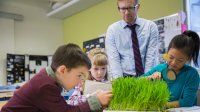9 Tips for Using Crosscutting Concepts to Boost Students’ Scientific Thinking
Introducing elementary students to ideas that apply across disciplines enhances their understanding of the sciences as an interconnected whole.
Your content has been saved!
Go to My Saved Content.Science education, we believe, is nothing more, or less, than learning how to think. There’s a body of research that points to fundamental differences in how novices and experts organize information.
Experts have a more organized and interconnected knowledge base with a deep understanding of the underlying principles and concepts within a domain. Novices have less organized and less interconnected knowledge in a domain. They may have a basic understanding of some concepts, but their knowledge lacks the depth and breadth of experts.
Crosscutting concepts can enable elementary teachers to help students connect concepts across different disciplines in science, sowing the seeds for thinking like an expert.
In our work with elementary school colleagues as STEAM professional development specialists, we refer to crosscutting concepts as “how students think” about science. There are seven crosscutting concepts (patterns, cause and effect, scale proportion and quantity, systems and system models, energy and matter, structure and function, and stability and change), and we are very intentional in their use.
We use Next Generation Science Standards (NGSS) documents to make sure we’re aligning the proper crosscutting concept with the lessons and concepts we’re teaching. We then use these concepts to give our students a tool to align characteristics of how experts think about a topic.
By consistently incorporating crosscutting concepts into our elementary science instruction, we help students develop a deeper understanding of science as a whole and make connections between scientific concepts in four domains: physical science; life science; earth and space science; and engineering, technology, and applications of science.
incorporating crosscutting concepts into science instruction
1. Introduce the crosscutting concept. Begin each lesson by presenting the crosscutting concept you’ll be focusing on. Use our student-friendly anchor charts as a visual aid to facilitate discussions with the students.
For example, since second-grade students are learning about interdependent relationships in ecosystems, plant growth should be delivered through the lens of cause-and-effect relationships.
2. Engage students in scientific inquiry. Aligning science questions to the crosscutting concepts requires a deliberate and intentional approach to crafting questions that elicit understanding of these overarching themes. Although this strategy is one of our favorites, we use it only with students in grades three and above because of developmental appropriateness.
We support students by analyzing exemplary models and consistently encouraging them to develop scientific questions that align to different crosscutting concepts. Here are some examples of models we have used with students:
- In a grade three unit on Inheritance and Variation of Traits: Life Cycles and Traits, you can model the crosscutting concept of “patterns” with How do different animal species share common patterns in their physical and behavioral adaptations?
- In a grade four unit on Structure, Function, and Information Processing, model the crosscutting concept “cause and effect” with How does damage to a specific part of the brain affect a person’s ability to carry out specific tasks or functions?
- In a grade five unit on Structure and Properties of Matter, try modeling the crosscutting concept of “scale proportion and quantity” with How does the size of particles in a substance relate to the substance’s properties and behavior?
3. Use hands-on activities. Hands-on activities and experiments can help students understand how crosscutting concepts apply to real-world situations. For example, kindergarten students can develop an understanding of “patterns” by using observations to describe patterns of what plants and animals need to survive.
4. Use multimedia resources. Resources, such as videos, images, and simulations, can help students visualize crosscutting concepts and apply them to specific science topics. For example, in grade six you could use a PhET simulation to show the connection between “systems and system models,” indicating that gravitational interactions are attractive and depend on the masses of interacting objects.
5. Provide examples. Use real-world examples to illustrate how the crosscutting concept applies to the core idea you’re teaching. For example, a real-world scenario in first grade that represents “structure and function” would be biomimicry: how humans are inspired by nature and design solutions to problems.
6. Encourage discussion. Engage your students in a discussion about the crosscutting concept and how it applies to the core idea they’re working on. Ask open-ended questions to encourage critical thinking and students’ sharing their examples. Students can also collaborate in groups and discuss how the crosscutting concept relates to their work.
7. Make connections. Encourage students to make connections between the crosscutting concept and the varied core ideas they’ve learned. For example, grade three students could make connections between their work with the water cycle in one unit and environmental changes in another unit. The crosscutting concept “systems and system models” applies to both.
8. Reinforce the concept. Throughout the lesson, refer back to the crosscutting concept and encourage students to think about how it applies to the core idea you’re teaching. At the end of the lesson, use our anchor charts and review the crosscutting concept, and then provide opportunities for students to apply it to new situations.
9. Summarize and synthesize. Guide students in summarizing and synthesizing the crosscutting concepts to consolidate their learning using graphic organizers, concept maps, summary statements, or reflective writing; more innovative examples could be through the use of digital tools.
Incorporating crosscutting concepts into teaching practices can significantly enhance student thinking and learning. Elementary teachers can help students not only connect concepts across different science domains but also develop a more holistic understanding of the world around them. This approach helps move students from novice thinking to expert thinking by encouraging them to think critically, make connections, and apply their knowledge to real-world problems.
Crosscutting concepts are a powerful educational tool that can improve student learning outcomes and prepare them for success in a complex and interconnected world.
